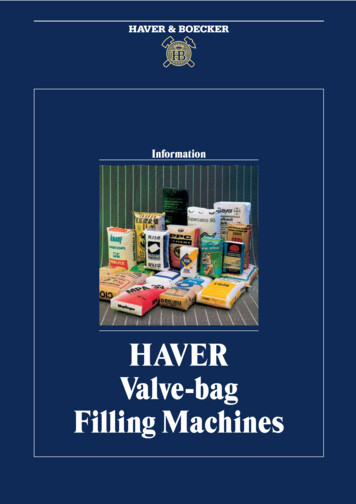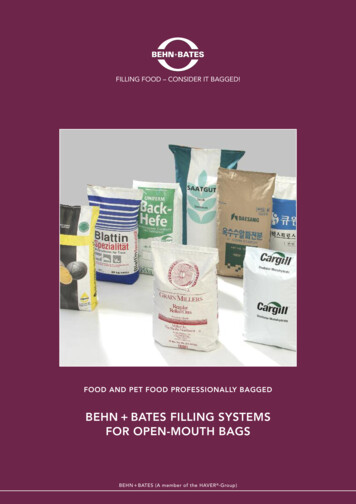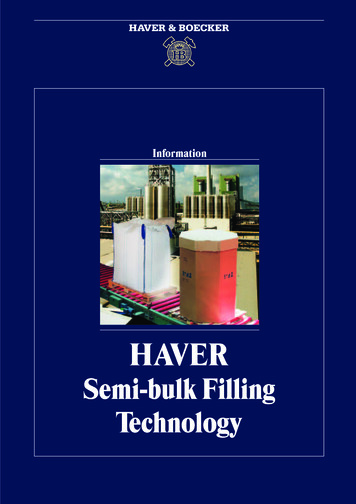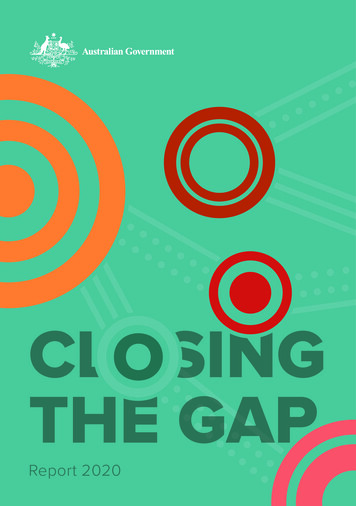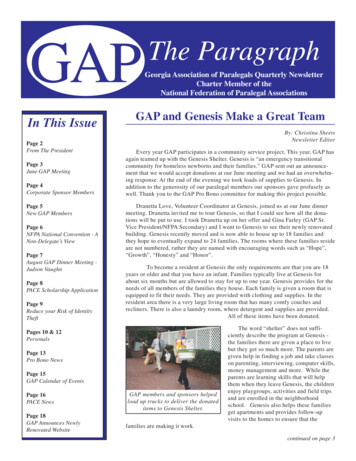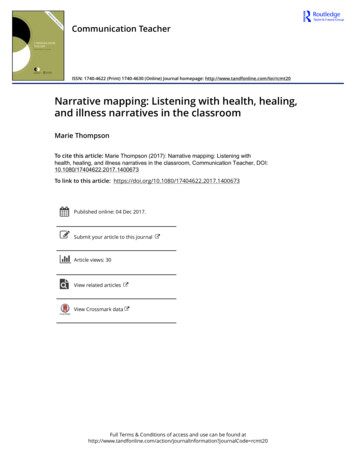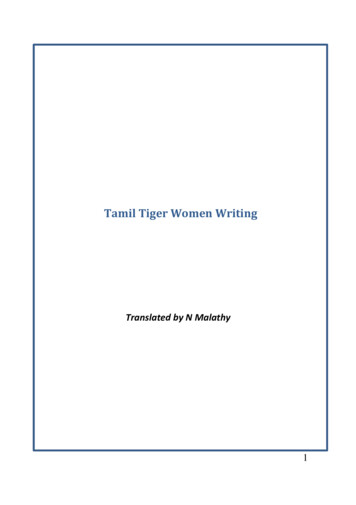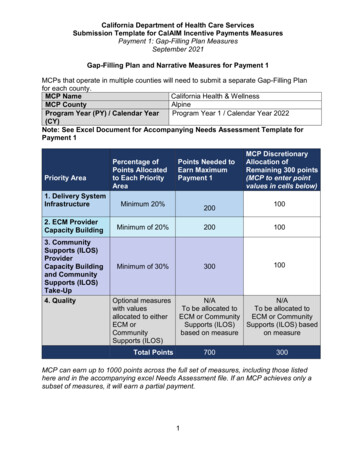
Transcription
California Department of Health Care ServicesSubmission Template for CalAIM Incentive Payments MeasuresPayment 1: Gap-Filling Plan MeasuresSeptember 2021Gap-Filling Plan and Narrative Measures for Payment 1MCPs that operate in multiple counties will need to submit a separate Gap-Filling Planfor each county.MCP NameCalifornia Health & WellnessAlpineMCP CountyProgram Year (PY) / Calendar YearProgram Year 1 / Calendar Year 2022(CY)Note: See Excel Document for Accompanying Needs Assessment Template forPayment 1Priority AreaPercentage ofPoints Allocatedto Each PriorityAreaPoints Needed toEarn MaximumPayment 1MCP DiscretionaryAllocation ofRemaining 300 points(MCP to enter pointvalues in cells below)1. Delivery SystemInfrastructureMinimum 20%2. ECM ProviderCapacity BuildingMinimum of 20%200100Minimum of 30%3001003. CommunitySupports (ILOS)ProviderCapacity Buildingand CommunitySupports (ILOS)Take-Up4. QualityOptional measureswith valuesallocated to eitherECM orCommunitySupports (ILOS)200100N/AN/ATo be allocated toTo be allocated toECM or CommunityECM or CommunitySupports (ILOS)Supports (ILOS) basedbased on measureon measureTotal Points700300MCP can earn up to 1000 points across the full set of measures, including those listedhere and in the accompanying excel Needs Assessment file. If an MCP achieves only asubset of measures, it will earn a partial payment.1
California Department of Health Care ServicesSubmission Template for CalAIM Incentive Payments MeasuresPayment 1: Gap-Filling Plan MeasuresSeptember 2021Option for MCP to request more than 300 points to be allocated at theirdiscretion. Please describe (in the box below) the preferred allocation andreason if MCP is requesting allocation different from that above. 100 word limit1. Request: reallocate 20 points from 1.3.3 and 10 points from 1.3.4 to PriorityArea 1.2. We are committed to offering all CS by 1/1/2024. These points cannot beearned in their current measures because we are taking a thoughtfulapproach to identifying andexpanding community-based capacity in a waythat focuses on member access, experience, quality, and outcomes. Ourresponse to 1.3.5 #2 emphasizes our commitment and approach toincreasing the number and reach of CS in Alpine County.3. Justification: Reallocating these points to Priority Area 1 enables us to makemeaningful investments in delivery system infrastructure.2
California Department of Health Care ServicesSubmission Template for CalAIM Incentive Payments MeasuresPayment 1: Gap-Filling Plan MeasuresSeptember 2021DHCS initially set gap-filling targets in the Reporting Template of at least 20%, based on the Gap-Filling plan. If gaps arelower than 30%, MCPs are expected to identify an appropriate gap-filling target in their narrative entry to be approved byDHCS. In instances where MCPs do not have a gap for the measure, they may propose an alternative target forachievement. DHCS will review all MCP-proposed gap filling targets and adjust those as needed to meet programrequirements.Narrative Measures for Priority Area 1: Delivery System InfrastructureGap-Filling Plan1.1.6 Measure DescriptionMandatory80 pointsSubmission of a narrative Gap-Filling plan describing how MCPs will identify underserved populations and the ECMproviders they are assigned to, and enhance those ECM Providers' capabilities to:(1) Electronically exchange care plan information and clinical documents with other care team members.(2) Have access to certified EHR technology or a care management documentation system able to generate andmanage a patient care plan.(3) Submit a claim or invoice to an MCP or have access to a system or service that can process and send a claim orinvoice to an MCP with information necessary for the MCP to submit a compliant encounter to DHCS.MCPs should also describe any plans to build physical plant (e.g., sobering centers) or other infrastructure to supportthe launch of ECM and Community Supports (ILOS).Gap-Filling Plan narrative should include approaches for collaborating with entities, including but not limited to, countysocial services, county behavioral health, public healthcare systems, county/local public health jurisdictions, communitybased organizations (CBOs), correctional partners, housing continuum and others within the county to achieve theabove activities, and should describe how health plans will leverage existing WPC infrastructure, including how they willtrack the ongoing viability of WPC infrastructure and improve data integration across behavioral health and physicalhealth providers.3
California Department of Health Care ServicesSubmission Template for CalAIM Incentive Payments MeasuresPayment 1: Gap-Filling Plan MeasuresSeptember 2021MCP Submission1. Describe approach toidentify top 3-4underservedpopulations in Countyand the ECMproviders they areassigned to100 word limit2. Describe 3-4 concretesteps MCP will take toincrease, by at least20%, ECM Providercapabilities toelectronicallyexchange care planinformation andclinical documentswith other care teammembers100 word limit3. Describe 3-4 concretesteps the MCP willtake to increase, by atleast 20%, ECMProvider access tocertified EHRtechnology or a caremanagementdocumentationsystem able toCH&W will collaborate with County and Plan partners to identify the top underservedpopulations in Alpine County. To determine ECM provider assignment, we will: 1)include DHCS logic in Population Health Management stratification algorithms to identifypotentiallyeligible populations; 2) solicit and integrate data from housing agencies andother County agencies to improve identification, targeting, and assignments over time;and 3) identify providers' expertise serving the needs of populations of focus to assignmembers appropriately.CH&W understands providers have varying levels of capability and is exploring amultifaceted approach to meet providers where they are by: 1) increasing connectivitywithHIEs and exploring whether HIEs may be able to support the ability to share careplans; 2)connecting with local Community Information Exchanges where they exist; 3)enhancing plan capabilities to allow care plan sharing through our care managementand provider portal platforms; 4) facilitating data exchange for key care plan elements;and 5) engagingin county-wide collaborations to leverage county-wide and standardizedsolutions where possible, including joint trainings.CH&W will survey our contracted ECM providers to determine their ability to accesscertifiedEHR technology or a care management documentation system able to generateand manage a patient care plan, including requesting feedback on limitations/barriers.CH&W willtake the following steps to increase, by at least 20%, ECM provider capabilitiesin this area:1) assess and share findings, 2) partner to identify solutions that can be adopted, 3)identifyopportunities to support the adoption of technology through the IPP, and 4) developjoint training and provider engagement opportunities, where possible.4
California Department of Health Care ServicesSubmission Template for CalAIM Incentive Payments MeasuresPayment 1: Gap-Filling Plan MeasuresSeptember 2021generate and managea patient care plan100 word limit4. Describe 3-4 concretesteps the MCP willtake to increase, by atleast 20%, ECMProvider abilities tosubmit a claim orinvoice to an MCP orhave access to asystem or service thatcan process and senda claim or invoice toan MCP withinformation necessaryfor the MCP to submita compliant encounterto DHCS100 word limit5. Describe approachesfor collaborating with,Social Services,County BehavioralHealth, andCounty/Local PublicHealth Agencieswithin the county toimprove dataintegration andelectronic dataCH&W will survey our ECM providers to determine ability to submit a claim or invoice oraccess to a system or service that can process and send a claim or invoice to an MCP,including requesting feedback on limitations/barriers. We will take the following steps toincrease, by at least 20%, ECM provider capabilities in this area: 1) assess and sharefindings, 2) identify opportunities to support development of capabilities through the IPP,and3) develop training and engagement opportunities, including training providers toleverageour portal or other tools to submit claims/invoices, where possible.Through a CalAIM Roundtable, CH&W will collaborate with our Plan, County, providerpartners within Alpine County to improve data integration and electronic data sharingcapabilities using best practices. Efforts include: 1) understanding current state of dataexchange within Alpine County, including HIEs, CIEs, HMIS, justice involved systems,BH, foster care and other datasets critical to supporting whole person care; 2)collaborating on a process to modernize data sharing agreements; 3) collaborating on acounty-wide multi-yearroadmap to achieve optimal levels of integration; and 4) identifyingsources of funding that can be braided together to support the requisite levels ofintegration.5
California Department of Health Care ServicesSubmission Template for CalAIM Incentive Payments MeasuresPayment 1: Gap-Filling Plan MeasuresSeptember 2021sharing, capabilitiesamong physicalhealth, behavioralhealth and socialservice providers100 word limit6. Describe approach forleveraging existingWPC infrastructure (ifin WPC county),including tracking theongoing viability ofWPC infrastructureand improving dataintegration acrossbehavioral health andphysical healthproviders100 word limit7. Any additionalInformation onDelivery SystemInfrastructure Gaps inCounty100 word limitNot applicable. Alpine County does not participate in the WPC pilot.CH&W is conducting a pre-contractual comprehensive assessment of interestedproviders/entities. Developed in collaboration with Plan partners state-wide, thisassessment evaluates existing capabilities, infrastructure, provider capacity, theprovider’s ability to integrate with primary and/or specialty care providers, and identify anygaps or needs that require Plan support. We will partner with these providers to fill anyidentified gaps or needs to ensure a successful program implementation. Further, CH&Wwill work in collaboration with County partners, Plan partners, and ECM providers to betterintegrate health care, social services, and justice systems and processes.6
California Department of Health Care ServicesSubmission Template for CalAIM Incentive Payments MeasuresPayment 1: Gap-Filling Plan MeasuresSeptember 2021Narrative Measures for Priority Area 2: ECM Provider Capacity BuildingGap-Filling Plan1.2.5 Measure DescriptionMandatory70 pointsSubmission of a narrative Gap-Filling plan demonstrating:(1) How the MCP will address identified gaps in ECM Provider capacity for Program Year 1 Populations of Focus.(2) Identified ECM workforce, training, TA needs in county, including specific cultural competency needs by county.(3) Plan for ECM Provider workforce recruiting and hiring of necessary staff to build capacity.(4) Approach for MCP to develop and administer an MCP training and TA program for ECM Providers.(5) Strategy to ensure ECM Providers are successfully engaging with hard to reach Populations of Focus, includinghomeless and justice involved populations, among others.(6) Approach to build, develop, or invest in the necessary behavioral health workforce to support the launch of ECMGap-Filling Plan narrative should include approach for collaborating with other entities, including but not limited to,county social services, county behavioral health, public healthcare systems, county/local public health jurisdictions,community based organizations (CBOs), correctional partners, housing continuum, Tribes and Tribal providers (exceptfor Plans in Counties without recognized Tribes), ECM providers and others to achieve the above activities, improveoutreach to and engagement with hard to reach individuals within each Populations of Focus and reduce underlyinghealth disparitiesMCP Submission1. Describe approachCH&W has been heavily engaged with our Plan and County partners, providers, and CBOsto addressto address identified gaps in ECM provider capacity in Alpine County, which have beenidentified gaps ininformed through our provider capacity survey and ongoing provider engagement. StrategiesECM Providerinclude continually evaluating network and contracting opportunities; monitoring capacity,capacity forincluding caseloads and engagement rates; supporting providers through coaching andProgram Year 1partnership; implementing incentive programs to ensure effectiveness; and holding providersPopulations ofaccountable toeffectively deploying incentive dollars. The CalAIM Roundtable will provide usFocus andanother opportunity to continue active local-level discussions to address identified gaps.proposed targets,7
California Department of Health Care ServicesSubmission Template for CalAIM Incentive Payments MeasuresPayment 1: Gap-Filling Plan MeasuresSeptember 20212.3.4.5.of at least 20%improvement, toaddress gaps100 word limitIdentify ECMworkforce, training,and TA needs incounty, includingspecific culturalcompetency needsby county100 word limitDescribe plan forECM Providerworkforce recruitingand hiring ofnecessary staff tobuild and increasecapacity by at least20%100 word limitDescribe approachto develop andadminister an MCPtraining and TAprogram for ECMProviders100 word limitDescribe strategyto ensure ECMProviders areCH&W will survey ECM providers to identify workforce, training, and TA needs in AlpineCounty, including managed care 101, motivational interviewing, member engagement,and person-centered care planning. Leveraging a CalAIM Roundtable, we will reviewresults with our plan, county, provider, and CBO partners to jointly identify and implementopportunities toaddress stated needs. Strategies include identifying culturally responsiveorganizations with workforce development expertise in populations of focus and methodsto incorporate lived experiences to develop curriculum to improve effectiveness andcreate a pipeline of talent,providing technical assistance and training, and others.We will survey ECM providers to understand their workforce needs, including current andplanned FTEs, caseload, and staffing needs or gaps. Based on the results, we will continuelocal level discussions to understand how to best support workforce development with ourPlan,County, provider, and CBO partners. We will identify efforts already in place to ensurenon- duplication. These discussions will inform our investment approach to supportworkforce recruiting and hiring. To support culturally-responsive care, we will focus onworkforce development and capacity building of staff with lived experiences, in addition tolocal providers with trust and credibility in their communities.CH&W will survey ECM providers to understand their areas of expertise and their trainingandTA needs. Based on the results, we have developed a training and TA program thatuses liveand on-demand webinars on topics including authorizations, referrals, claims,eligibility, data sharing, member engagement, grievances and appeals, operations, andothers. We will continue local level discussions with our Plan partner to identify regionaland/or statewide opportunities to collaborate on training and TA needs to minimize burdenon our providers,where possible.To ensure ECM providers are successfully engaging with hard-to-reach Populations ofFocusin Alpine County, CH&W will use our established mechanisms to conduct oversight,8
California Department of Health Care ServicesSubmission Template for CalAIM Incentive Payments MeasuresPayment 1: Gap-Filling Plan MeasuresSeptember 2021successfullyengaging with hardto reachPopulations ofFocus, includinghomeless andjustice involvedpopulations, amongothers100 word limit6. Describeapproaches forcollaborating with,Social Services,County BehavioralHealth, andCounty/LocalPublic HealthAgencies within thecounty to achievethe above activities100 word limit7. Describe approachto build, develop, orinvest in thenecessarybehavioral healthworkforce tosupport the launchof ECM100 word limitmonitoring, identify outliers, and engage with providers to implement improvement plans.We will also leverage a CalAIM Roundtable to facilitate collaboration with Plan, County,provider, and CBO partners, enabling us to jointly identify barriers and local system-wideimprovementsneeded to successfully engage hard-to-reach populations; discuss bestpractices; develop provider education, training, and tools on member referrals andengagement; and implement methods to track engagement rates and continually assessprogress.Through a CalAIM Roundtable which will meet at least quarterly, CH&W and our plan,county, provider, and CBO partners will ensure involvement of key stakeholders,includingbut not limited to, county social services, county behavioral health, publichealthcare systems, county/local public health jurisdictions, CBOs, correctionalpartners, housing continuum, Tribes and Tribal providers, ECM providers and others toachieve the above activities, improve outreach to and engagement with hard to reachindividuals within eachPopulations of Focus, and reduce underlying health disparities.We recognize and are committed to partnering to address the statewide, systemic issue ofbehavioral health workforce shortages. CH&W will survey our ECM behavioral healthprovidersto understand workforce needs, including specific questions about current andplanned FTEs, caseload, and staffing needs or gaps. Based on the results, we will continuelocal level discussions to understand how we may best support behavioral health workforcedevelopment with our plan, county, provider, and CBO partners. We will also conductenvironmental scans toidentify efforts already in place to ensure non-duplication of efforts.These discussions will inform our behavioral health workforce investment approach.9
California Department of Health Care ServicesSubmission Template for CalAIM Incentive Payments MeasuresPayment 1: Gap-Filling Plan MeasuresSeptember 2021Community Partners1.2.6 Measure DescriptionOptionalReport on One Optional Measure in ECM Provider Capacity Building Priority Area to Earn 30 PointsNarrative summary that outlines landscape of Providers, faith-based groups, community-based organizations, andcounty behavioral health care providers and county behavioral health networks in the county and submission of anarrative plan to develop an MOU or other agreements with a subset of Providers, faith-based groups, county agenciesand community-based organizations in the county to develop strategies for closing health disparities experienced byPopulations of Focus, including agreement to meet at least quarterly to advance strategy.MCP Submission1. Describe thea. Alpine County Health Department Clinic is a key potential ECM provider in Alpinelandscape in theCounty,in addition to statewide providers.county of:a. ECMb&c. Per findhelp.org, there are at least 49 potential CBOs, inclusive of faith-basedb. Providersgroups, inAlpine County. We are continually building new relationships and strengtheningc. Faith-basedexisting relationships.groupsd. Communityd. Alpine County Department of Behavioral Health directly operates 4 programs/sites andbasedcontracts with 7 community providers. Alpine County Department of Behavioral Healthorganizationscurrently works with 2 SUD providers in the county. These numbers may not include othere. Countycommunity clinics and/or private providers of BH services.behavioralhealth careproviders andcountybehavioralhealthnetworks100 word limit10
California Department of Health Care ServicesSubmission Template for CalAIM Incentive Payments MeasuresPayment 1: Gap-Filling Plan MeasuresSeptember 20212. Describeapproach to fosterrelationships witha subset of theorganizationsdescribed abovein 1. Approachshould include atleast quarterlymeetings, and canpotentially includeand MOU or letterof agreement100 word limit3. Describe thestrategy forclosing identifiedhealth disparitieswith at least onestrategy for eachpopulation offocus that will golive in the Countyin 2022, for a totalof at least fiveidentified healthdisparities100 word limitCH&W has existing relationships in Alpine County and we continually seek opportunities tobuildnew relationships. Through a CalAIM Roundtable which will meet at least quarterly, CH&Wand our plan, county, provider, and CBO partners will ensure involvement of key stakeholders,including but not limited to the organization and provider types listed above. The attachedLetterof Collaboration documents the collaboration MCPs have agreed to, and we look forwardto partnering with the organization types listed above to establish a joint vision for CalAIMstakeholder engagement (i.e., charter, shared mission/vision, MOU, letter of agreement).1. Disparities obtaining care post-hospitalization for adults experiencinghomelessness:Enable ECM to facilitate timely post discharge care.2. Underdiagnoses of adults with SUD: Ensure ECM provers screen and linkmembers toappropriate care.3. Adult high utilizers with:a. Co-occurring chronic conditions: Lifestyle factors contribute to worseninghealthconditions. Partner ECM with plan clinical pharmacists to manage.b. Serious chronic illness: Unaware of benefits of Palliative Care. EnsureECMproviders refer to Palliative Care Program.c. Frequent ED visits: Barriers connecting to medical home. Use predictiveanalytics to identify members. Enable ECM providers connect with usualcare and supports11
California Department of Health Care ServicesSubmission Template for CalAIM Incentive Payments MeasuresPayment 1: Gap-Filling Plan MeasuresSeptember 2021Tribal Engagement1.2.7 Measure DescriptionMandatory30 pointsNarrative summary that outlines landscape of Tribes, Tribal providers used by members in the county, and members inthe county who use Tribal services, and submission of a narrative plan to develop an MOU to establish a strategicpartnership with Tribes and Tribal providers in county to develop Provider capacity and provision of ECM services formembers of TribesMCP Submission1. Outline the landscapeFederally recognized Tribes in Alpine County include: Washoe Tribe of CA and NV.of Tribes, Tribal(Source:NCIDC)providers, andmembers in theThe tribal designations of the California Indians in Alpine County are: Northern Paiute; Sierracounty who use Tribal Miwok; Washo. (Source: UC Berkeley)services and will needECM supportsThere are no Tribal providers in the county.100 word limitWe do not estimate any CH&W members in Alpine County who use Tribal services will useECM.2. Outline a plan toCH&W strongly supports Tribes and Tribal providers across the state, including thoseestablish a strategicidentified above in Alpine County. While there are no Tribal providers in Alpine County, wepartnership includingwork with the entities that have expertise in serving Tribal nations, such as the Californiaany plans forRural Indian Health Board, California Consortium for Urban Indian Health, and Office offormalization such asTribal Health Affairs, to develop culturally responsive strategies across the state. We area MOU or otheralsopartnering with our Plan partners to ensure a unified approach where possible,agreementsincluding partnering on joint educational webinars and ensuring these entities are included100 word limitin regular stakeholder engagement meetings and activities.3. Describe plan toCH&W will engage with Tribes to address identified gaps in ECM provider capacity in Alpinedevelop providerCounty. Through a CalAIM Roundtable, we will continue active local-level discussions tocapacity and ECMfurther develop ECM capacity for members accessing Tribal services. Strategies include12
California Department of Health Care ServicesSubmission Template for CalAIM Incentive Payments MeasuresPayment 1: Gap-Filling Plan MeasuresSeptember 2021services for members100 word limitcontinually evaluating network and contracting opportunities; collaborating to enhanceworkforce development/pipeline; providing technical assistance and training; and supportingproviders in expanding their footprint.Engagement for Key Population of Focus: People Experiencing Homelessness or Chronic Homelessness1.2.9 Measure DescriptionMandatory30 pointsSubmission of narrative plan describing how the managed care plan will improve outreach to and engagement with thefollowing Population of Focus: "people experiencing homelessness or chronic homelessness, or who are at risk ofbecoming homeless with complex health and/or behavioral health conditions," with a focus on Black/African Americanand other racial and ethnic groups who are disproportionately experiencing homelessnessMCP Submission1. Identify andAlpine County has identified the following racial and ethnic groups that disproportionatelydescribe top 3 – 4experience homelessness in the County: (1) White and (2) American Indian/Alaska Native.racial and ethnicBased on data including unhoused population, proportion to total membership, admits, andgroups that areemergency department data, CH&W identified that (3) Hispanic/Latinx individuals alsodisproportionatelyexperience disproportionately high rates of homelessness in Alpine County.experiencinghomelessness inthe county100 word limit2. Describe approachCH&W will improve outreach and engagement to the populations listed above by leveragingto improve outreachour partnerships with homeless providers in Alpine County, including but not limited to theand engagement byEastern Sierra Continuum of Care, and the coordinated entry system. Utilizing local,at least 20% tostatewide, and national best practices and insights, we engage with trusted messengers inBlack/Africanthecommunity to provide culturally responsive outreach and meet members where they are,American and othermeeting immediate needs first and connecting them to culturally appropriate resources (e.g.,racial and ethnicstreet medicine). To ensure alignment, we will discuss outreach and engagement to thesegroups who arepopulations in a CalAIM Roundtable.13
California Department of Health Care ServicesSubmission Template for CalAIM Incentive Payments MeasuresPayment 1: Gap-Filling Plan MeasuresSeptember 2021disproportionatelyexperiencinghomelessness100 word limitEngagement for Key Population of Focus: Individuals Transitioning from Incarceration1.2.10 Measure DescriptionOptionalReport on One Optional Measure in ECM Provider Capacity Building Priority Area to Earn 30 PointsSubmission of narrative plan describing how the managed care plan will improve outreach to and engagement with thefollowing Population of Focus: "individuals transitioning from incarceration who have significant complex physical orbehavioral health needs requiring immediate transition of services to the community," with a focus on Black/AfricanAmerican and other racial and ethnic groups who are disproportionately experiencing transitions from incarcerationsettings in the county.MCP Submission1. Identify and describeBased on statewide data from the Prison Policy Initiative, the following racial andtop 3 – 4 racial andethnicgroups experience disproportionately high incarceration rates in California: (1)ethnic groups that areBlack/African American (6% of population, 27% of incarcerated population) (2) Latinoincarcerated in the(38% of population, 41% of incarcerated population), and (3) Native American (1% ofcountypopulation and incarcerated population). We use this data, along with county-level100 word limitpopulation and membership data, to identify and address these disparities in AlpineCounty. We have also requested this data from our County partners. According to ouradditional research, race/ethnicity incarceration data is not readily available in AlpineCounty.2. Describe approach toCH&W will improve outreach and engagement to populations disproportionatelyimprove outreach andexperiencing transitions from incarceration by leveraging our partnerships with ECMengagement by at leastproviders; County and CBO partners, including but not limited to the County BH20% to Black/AfricanDepartment and the Eastern Sierra CoC; and leveraging data from correctional facilities toAmerican and otherinform care planning. Utilizing local, statewide, and national best practices, we engageracial and ethnicwith trusted messengers in the community to provide culturally responsive outreach andgroups who aremeet members where they are (i.e., engaging members pre-release, connecting members14
California Department of Health Care ServicesSubmission Template for CalAIM Incentive Payments MeasuresPayment 1: Gap-Filling Plan MeasuresSeptember 2021disproportionatelyexperiencing transitionsfrom incarcerationsettings in the county100 word limitto peers/individuals with lived experience). We will discuss additional strategies in aCalAIM Roundtable to ensure alignment.Narrative Measures for Priority Area 3: Community Supports (ILOS) Provider Capacity Building & Take-UpGap-Filling Plan1.3.5 Measure DescriptionMandatory80 pointsSubmission of a narrative Gap-Filling plan describing:(1) Identified gaps or limitations in Community Supports (ILOS) coverage within county(2) Plan to increase number and/or reach of Community Supports (ILOS) offered in January 2022 or July 2022(3) Identified Community Supports (ILOS) Provider capacity and MCP oversight capability gaps and plan to addressgaps(4) Identified Community Supports (ILOS) workforce, training, TA needs in region / county, including specific culturalcompetency needs by region/county(5) Plan to develop and administer a training and TA program for Community Supports (ILOS) Providers(6) Plan to establish programs to support Community Supports (ILOS) workforce recruiting and hiring, includingincentives for Community Supports (ILOS) Providers to hire necessary staffGap-Filling Plan narrative should include approach for collaborating with other entities, including but not limited to,county social servi
(2) Have access to certified EHR technology or a care management documentation system able to generate and manage a patient care plan. (3) Submit a claim or invoice to an MCP or have access to a system or service that can process and send a claim or invoice to an MCP with information necessary for the MCP to submit a compliant encounter to DHCS.
